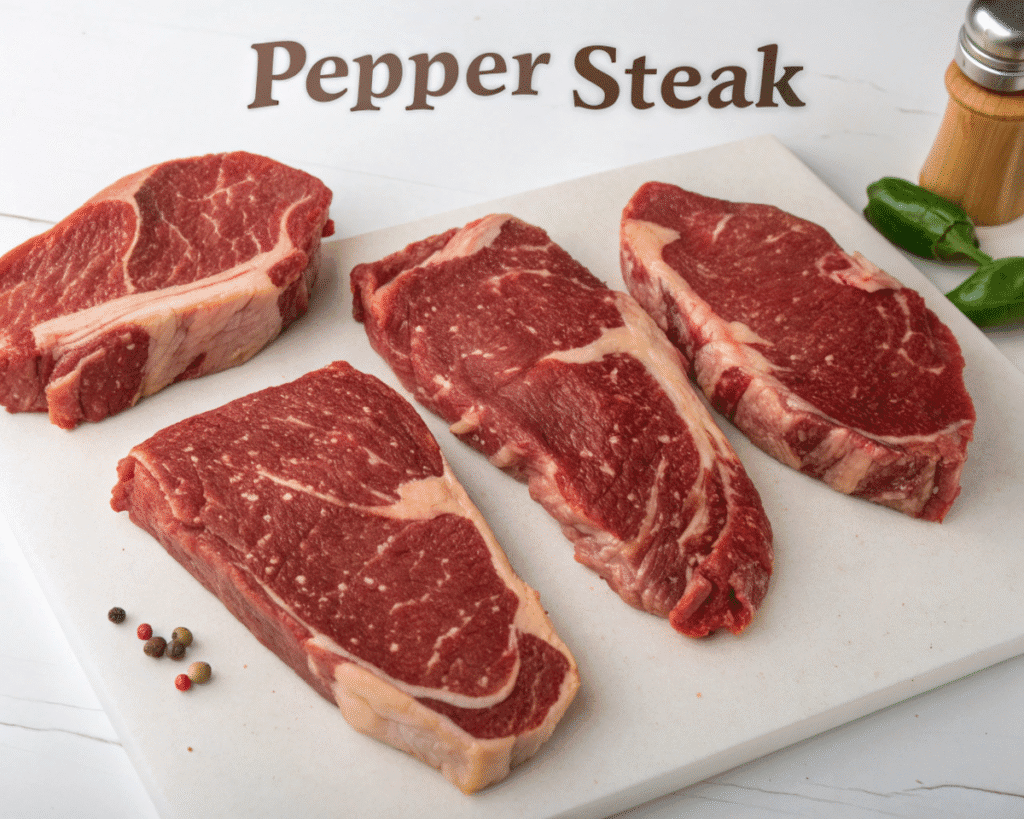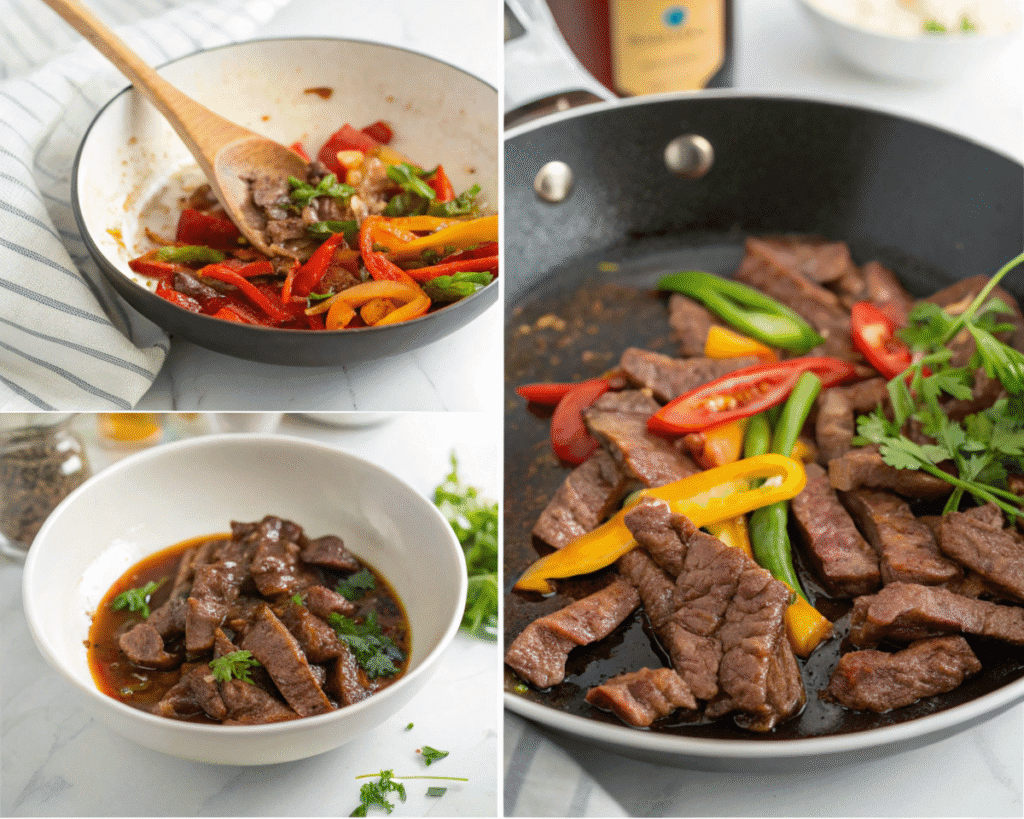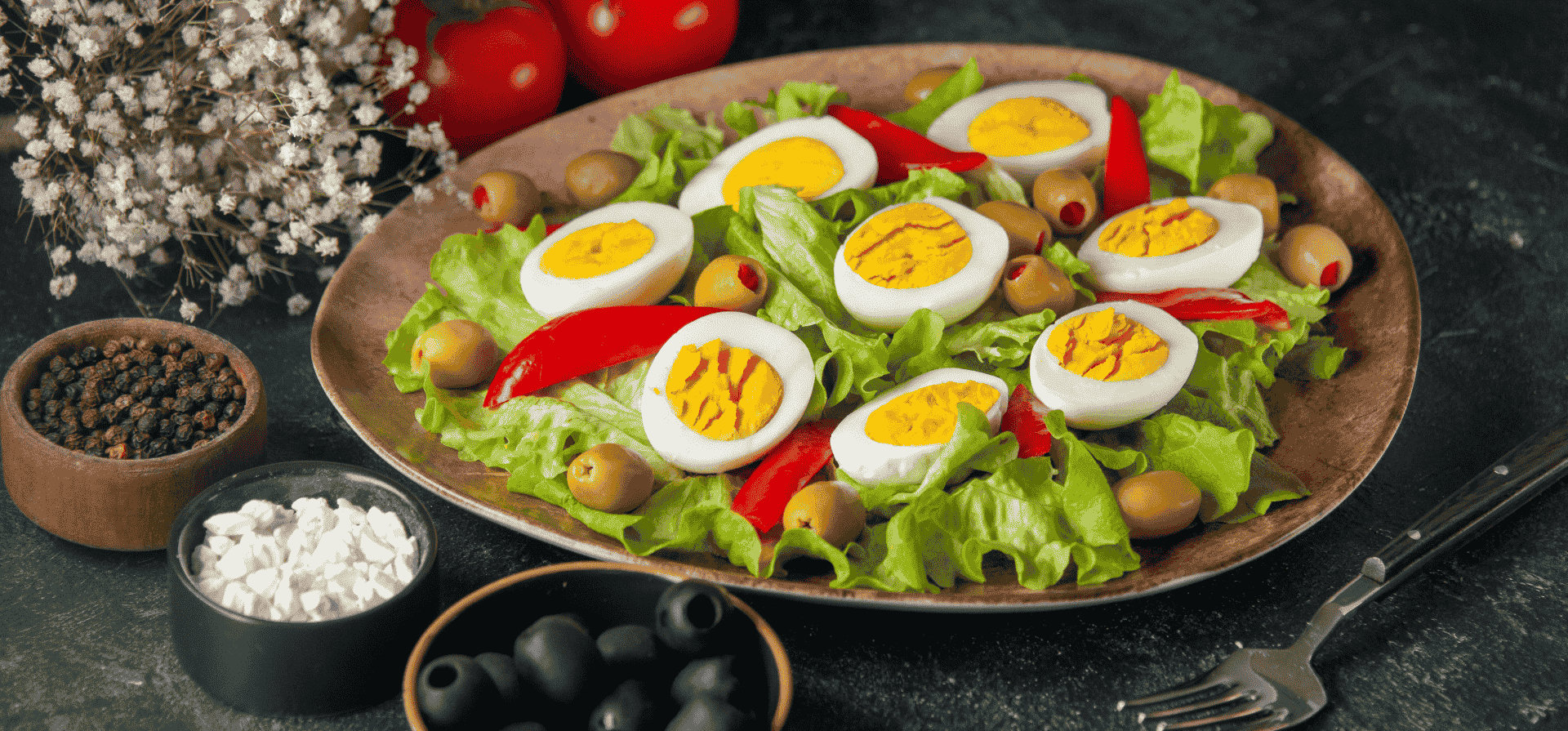The Ultimate Guide to Pepper Steak: Recipes, Tips, and Flavor Secrets
A sizzling skillet. A punch of soy sauce. Crisp bell peppers dancing with tender beef. That’s the magic of pepper steak, a dish that’s been wowing taste buds for decades.
In this ultimate guide, you’ll learn everything there is to know about this bold and flavorful stir-fry. We’ll walk you through its origins, help you pick the perfect cut of beef, and share a restaurant-style recipe that’s quick enough for busy weeknights. You’ll also discover expert cooking tips, tasty variations, and how to make it work for different diets. Oh—and we’re answering those burning questions you’ve probably Googled too.
What Is Pepper Steak?
Origins of Pepper Steak: From Fujian to America
Believe it or not, pepper steak didn’t start off as the takeout staple you know and love today. It actually traces back to a Chinese dish called qīngjiāo ròusī, a Fujian-style stir-fry that combines strips of meat with green bell peppers and soy-based sauce. As Chinese immigrants brought their culinary traditions to the West, they adapted this humble dish into the version we now devour in everything from mall food courts to home kitchens.
Today’s pepper steak is a Chinese-American comfort food classic—savory, slightly sweet, with just enough black peppery kick to keep things interesting. It’s usually served with rice, but some folks swap in noodles or even stuff it into wraps. The dish has morphed over time, taking on local twists and ingredient upgrades, but its soul has stayed the same: bold flavors, quick cooking, and beef that melts in your mouth.
What Makes Pepper Steak Unique Among Stir-Fry Dishes?
For starters, it’s the pepper-forward flavor. Unlike other stir-fries that lean heavily on ginger or chili, this dish puts black pepper—and lots of it—front and center. Add in a glossy, umami-rich soy sauce base, and you’ve got a flavor bomb waiting to happen.
Then there’s the texture. The beef is often marinated to maximize tenderness, then flash-cooked over high heat to lock in juices. Paired with crisp-tender bell peppers, every bite hits that perfect balance of chew and crunch.
Whether you’re craving a protein-packed dinner or looking to recreate your favorite takeout meal, pepper steak checks all the boxes.
Absolutely! Here are Part 2 and Part 3 of your article on Pepper Steak, written to be SEO-friendly, engaging, and easy to read. I’ve ensured the keyword Pepper Steak is included naturally and multiple times, used short, clear language, and added a proper ingredients table with units as requested in Part 3.
Choosing the Right Cut of Beef for Pepper Steak

Best Cuts for Tender, Juicy Pepper Steak
If there’s one secret to nailing a delicious Pepper Steak, it starts with the cut of beef. Not all cuts are created equal—and if you want that soft, savory bite, you’ll need to choose wisely.
For the best results, go with top sirloin. It’s lean, easy to find, and stays tender when cooked fast over high heat. But if you’re craving something richer, ribeye or tenderloin will give your Pepper Steak an indulgent, buttery flavor.
On a tighter budget? Flank steak and skirt steak work well too. They’re full of flavor and become nice and tender when sliced right.
How to Slice Beef for Optimal Texture
No matter which cut you use, how you slice it matters just as much. To get that signature tender bite in your Pepper Steak, always slice against the grain. This breaks down the muscle fibers and keeps the meat from turning chewy.
Here’s a quick tip: chill your beef in the freezer for about 20 minutes before slicing. It firms it up and makes cutting thin, even strips much easier.
Keep those strips about 1/4 inch thick. Thin slices cook quickly, helping you sear the outside while keeping the inside juicy. And yes—don’t skip the marinade. Even 30 minutes can make a huge difference in flavor and texture.
Choosing the right cut and slicing it well is a small step, but it’s a game-changer for unforgettable Pepper Steak.
Classic Chinese Pepper Steak Recipe
Ingredients and Sauce Composition
This classic Chinese Pepper Steak recipe comes together in under 30 minutes. It’s packed with savory beef, crisp veggies, and a bold sauce that brings it all together. Plus, the ingredients are easy to find in any grocery store.
Here’s a quick table to guide your prep:
| Ingredient | Amount |
|---|---|
| Beef (top sirloin), sliced | 1 lb (450 g) |
| Soy sauce (reduced sodium) | 6 tbsp (90 ml), divided |
| Ground black pepper | 1/8 tsp (a pinch) |
| Cornstarch | 1 tbsp (8 g) |
| Beef broth | 1/2 cup (120 ml) |
| Garlic, minced | 1 clove |
| Fresh ginger, minced | 1/2 tsp (2 g) |
| Canola oil | 3 tsp (15 ml), divided |
| Red bell pepper, julienned | 1 cup (100 g) |
| Green bell pepper, sliced | 1 cup (100 g) |
| Mushrooms, sliced | 2 cups (150 g) |
| Tomatoes, cut in wedges | 2 medium |
| Green onions, chopped | 6 |
| Cooked white rice (optional) | As needed |
Step-by-Step Cooking Instructions

1. Marinate the Beef:
In a bowl, mix 3 tablespoons of soy sauce with black pepper. Add the beef and stir to coat evenly. Cover and refrigerate for 30–60 minutes.
2. Make the Sauce:
In a separate bowl, whisk together the remaining soy sauce, cornstarch, and beef broth. Set aside.
3. Stir-Fry the Beef:
Heat 2 teaspoons of oil in a large skillet or wok over medium-high heat. Add garlic and ginger; stir for 1 minute. Toss in the marinated beef and cook for 4–6 minutes until it’s no longer pink. Remove and keep warm.
4. Cook the Veggies:
Add the last teaspoon of oil to the same skillet. Stir-fry the red and green peppers for 1 minute, then add mushrooms. Cook for 2 more minutes until veggies are tender-crisp.
5. Finish the Dish:
Pour in the sauce, stir well, and let it boil. It’ll thicken in about 2 minutes. Add beef back to the skillet, along with tomatoes and green onions. Cook for another 2 minutes. Done!
Serve your Pepper Steak hot, over fluffy rice—or straight from the wok. Either way, it’s packed with flavor and ready in no time.
Pepper Steak Variations Around the World
Western-Style Pepper Steak with Tomatoes and Mushrooms
While Pepper Steak has Chinese roots, it’s taken on many flavors as it traveled. In the West, especially in the U.S., the dish often includes juicy tomatoes and mushrooms. These additions create a more stew-like vibe, bringing a heartier taste to the table.
Tomatoes add a sweet, tangy punch that balances well with the soy sauce and black pepper. Meanwhile, mushrooms give the dish a meaty depth—especially when you’re cooking for someone who loves texture.
This variation also leans toward thicker cuts of steak and sometimes even includes a dash of Worcestershire sauce. It’s not traditional, but it sure is tasty!
Spicy, Vegetarian, and Noodle-Based Pepper Steak Twists
Feeling bold? Add heat to your Pepper Steak with a touch of chili flakes, fresh jalapeños, or a spoonful of sambal. A little fire can really wake up the dish.
Not eating meat? No worries! Try swapping steak for extra-firm tofu, seitan, or even jackfruit. When marinated and stir-fried right, they mimic the texture of meat and absorb the sauce beautifully.
And if rice isn’t your jam, toss everything with lo mein, ramen, or even spaghetti. Noodles soak up the sauce and give the dish a fun twist. Pepper Steak is one of those meals that welcomes creativity—so go ahead and make it your own.
Cooking Techniques for the Perfect Stir-Fry
Wok vs. Skillet: Which Is Better for Pepper Steak?
One of the most common questions is, “Do I need a wok?” Well, the short answer is: it helps, but it’s not a dealbreaker.
Woks heat up fast and cook evenly, which is perfect for quick meals like Pepper Steak. They also give you more room to toss ingredients without overcrowding. That means better browning and less sogginess.
But if you don’t have a wok, no stress. A large, heavy-bottomed skillet (like cast iron) works almost just as well. Just make sure it’s hot before you add anything. A cold pan will steam your beef instead of searing it—and that’s a recipe for rubbery meat.
Heat Control, Oil Choice, and Common Mistakes
Getting the heat right is key. You want it high and fast. Stir-frying isn’t about slow and steady—it’s about searing and moving quickly. Keep the ingredients moving to avoid burning, and don’t walk away!
Use oils with high smoke points like canola, vegetable, or grapeseed oil. Olive oil? Save it for salads—it’ll smoke too soon.
Avoid these common mistakes:
- Overcrowding the pan – cook in batches.
- Using cold beef – let it come to room temp first.
- Skipping the prep – stir-frying is lightning fast, so have everything ready to go.
With the right tools, heat, and a bit of practice, you’ll be whipping up restaurant-worthy Pepper Steak in no time.
Craving more delicious dishes like Pepper Steak?
Be sure to check out our full recipe section for more flavorful and easy-to-make meals—like our refreshing Pistachio Pudding with Grapes, a perfect sweet contrast to your savory stir-fry!
What to Serve with Pepper Steak
Perfect Rice Pairings: Jasmine, Brown, or Fried?
When it comes to Pepper Steak, rice is the classic partner—and for good reason. Its soft, fluffy texture soaks up all that savory sauce and balances the bold flavors of the stir-fry.
If you love something fragrant, jasmine rice is a great pick. It’s slightly floral, cooks quickly, and adds a light touch to the plate. Prefer something a bit healthier? Then brown rice brings in more fiber and a nutty flavor that pairs beautifully with rich beef and veggies.
Feeling fancy? Go for fried rice. Toss in some scrambled eggs, green onions, and maybe a splash of sesame oil, and you’ve got a next-level side dish that almost steals the show.
Noodles, Salads, and Sides That Complement
Not a rice fan? No problem. Pepper Steak also goes great with stir-fried lo mein or ramen noodles. These noodles catch the sauce like a sponge and add a chewy contrast to the crisp veggies.
Or lighten things up with a side salad. A simple cucumber salad or Asian-style slaw with vinegar dressing gives a cool, fresh bite between those rich beefy forkfuls.
Want crunch? Add steamed or roasted broccoli, snow peas, or baby corn to your plate for even more color and texture.
Storing, Reheating, and Freezing Pepper Steak
How Long Can You Refrigerate or Freeze?
Pepper Steak stores surprisingly well—making it great for meal prep. Once cooled, place leftovers in an airtight container. You can keep them in the fridge for up to 4 days.
Need to save it longer? Just freeze it. Pepper Steak can be stored in a sealed freezer bag or container for up to 3 months. Don’t forget to label it with the date!
Reheating Without Losing Texture
No one wants soggy peppers or rubbery beef. So, when reheating your Pepper Steak, aim for low and slow.
For best results, warm it in a skillet over medium heat. Add a splash of water or beef broth to loosen the sauce and keep things juicy. Stir gently until heated through.
Microwaving is faster, but be careful. Reheat in 30-second bursts, stirring between each one. This helps avoid overcooking your beef.
If you’ve frozen the dish, let it thaw overnight in the fridge before reheating. While the veggies may soften slightly, the flavor will still shine through.
With the right storage tips, your Pepper Steak will taste just as good the second time around—maybe even better.
Health and Nutritional Profile of Pepper Steak
Calories, Macros, and Nutritional Highlights
Wondering if Pepper Steak fits into your healthy eating goals? Good news—it often does! With lean beef, colorful veggies, and a light soy-based sauce, this dish delivers big flavor without going overboard on calories.
On average, a single serving of Pepper Steak (about 1¼ cups without rice) contains:
- 240–260 calories
- Around 25g of protein
- About 10g of fat, with just a few grams of saturated fat
- Roughly 12–15g of carbs, mostly from the veggies and sauce
Plus, bell peppers pack a punch of vitamin C and fiber, while beef provides essential iron and B12.
Low-Sodium and Low-Carb Adaptations
If you’re watching your sodium intake, simply swap in low-sodium soy sauce or use coconut aminos instead. Want to cut carbs? Skip the rice and serve your Pepper Steak over steamed broccoli or cauliflower rice.
It’s easy to tweak the dish to fit your lifestyle—without losing that bold, savory taste.
FAQs About Pepper Steak
What is Pepper Steak Sauce Made Of?
Great question! Pepper Steak sauce is a savory blend of soy sauce, black pepper, garlic, and ginger. Many recipes add beef broth, cornstarch (for thickening), and a touch of sugar or vinegar for balance. It’s simple, but it brings the whole dish together.
Can I Make Pepper Steak in a Slow Cooker?
Yes, but with a twist. While traditional Pepper Steak is flash-fried, you can use a slow cooker for a softer, stew-like version. Just add sliced beef, peppers, onions, and the sauce to your slow cooker. Cook on low for 4–6 hours. The texture will be different—more tender, less crisp—but still tasty.
Is Pepper Steak the Same as Mongolian Beef?
Not quite. While both are beef stir-fries, Pepper Steak focuses on bell peppers and black pepper, while Mongolian beef is sweeter and often includes green onions and hoisin sauce.
What Veggies Go Best in Pepper Steak?
Bell peppers are the classic pick, but don’t stop there! Mushrooms, onions, baby corn, or even snow peas all work well.
Can I Meal Prep Pepper Steak?
Absolutely! Make a big batch, portion it into containers, and refrigerate or freeze. It reheats well, making Pepper Steak a smart, stress-free choice for lunch or dinner all week long.


